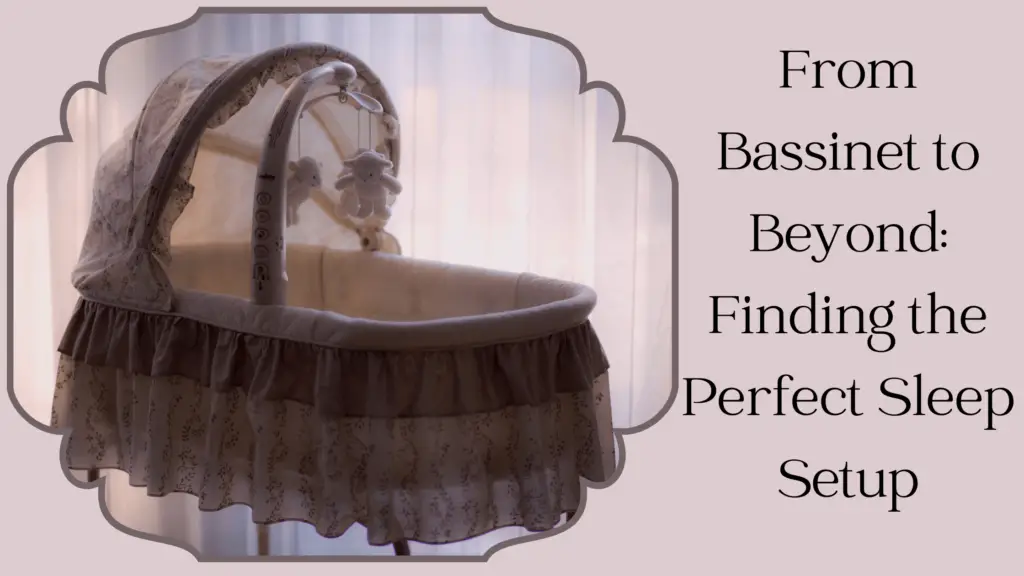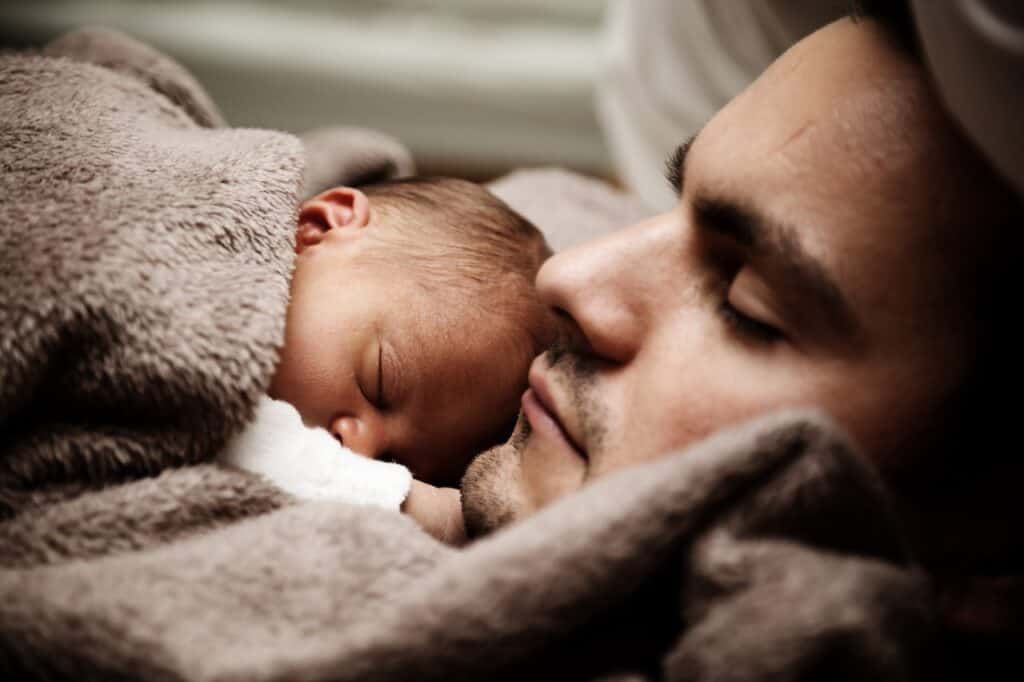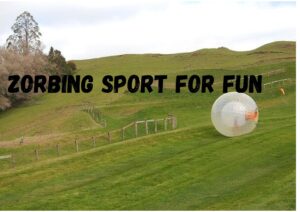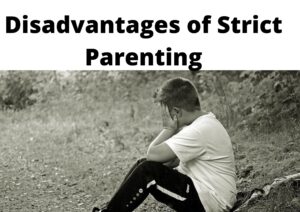I bet you’ve found yourself in the delicate dance of having a little one who’s outgrown their bassinet but isn’t quite ready to take on the world of cribs. This transition phase can leave you scratching your head, but fear not – we’ve got your back! So, what are the alternatives for a baby too big for bassinet but not ready for crib.
Pack-and-play, mini crib and bedside sleeper are the best alternative for a baby too big for bassinet but not ready for crib. These alternatives offer great convenience for parents. They also give your baby an experience that they would have if they transitioned to a crib since the bassinet is no longer an option.
The Transition Phase: Understanding Your Baby’s Sleep Needs
Babies grow at an astonishing pace, and their sleep habits evolve right alongside them. That once-comfy bassinet can suddenly start feeling like a tight squeeze as your little bundle of joy starts wiggling, rolling, and stretching to assert their newfound mobility. This phase typically occurs between the ages of four to six months, but remember, every baby dances to their own rhythm.
As you embark on this transition, pay close attention to your baby’s behavior. Are they getting a little restless in their bassinet? Are they attempting acrobatics you never thought possible? These signs are like little road markers indicating that your little one might be itching for a bit more room to stretch out during their slumber.
Baby Too Big for Bassinet but Not Ready for Crib: Alternatives to Consider
Here are the best alternatives to consider for a baby too big for bassinet but not ready for crib:
1. Pack-and-Play: A Versatile Sleep Haven
A pack-and-play, also known as a playard, offers a portable sleep solution that’s as adaptable as it is convenient. This option is a savvy choice for families with space constraints or those who love to rearrange their living quarters regularly.
Why Go for a Pack-and-Play?
- Portability: Easily move it from room to room, making it an excellent choice for daytime naps or when you’re visiting friends and family.
- Multi-Functionality: Some pack-and-plays come with nifty bassinet attachments suitable for younger infants, making them even more versatile.
- Space-Saving: A pack-and-play doesn’t gobble up your living space, which is perfect for those aiming to balance comfort and convenience.
Tips for Setting Up
- Choose the Right Surface: Opt for a flat and firm surface to ensure stability.
- Firm Mattress: Ensure the mattress is snug, fitting securely within the pack-and-play’s frame.
- Bedding Considerations: While you want a cozy space, avoid overly fluffy bedding that might pose suffocation risks.
Recommended Pack-and-Play: Graco Pack and Play
2. Mini Crib: Big on Comfort, Small on Space
Thinking of what exactly is a Mini Crib? Imagine a crib, but scaled down for pint-sized perfection. A mini crib brings the benefits of a full crib in a space-saving package, providing your growing baby with a safe sleep haven.
Why Opt for a Mini Crib?
- Space Efficiency: Ideal for urban dwellers or those working with limited nursery room real estate.
- Extended Usage: Many mini cribs are designed to grow with your child, accommodating them well into the toddler years.
- Sleep Continuity: The crib-like design can help maintain a familiar sleep environment as your baby transitions.
Choosing the Right Mini Crib
- Safety Certifications: Ensure your chosen mini crib meets established safety standards.
- Measure Twice: Gauge the available space in your room to guarantee a snug fit.
- Supportive Mattress: Pick a mattress that provides the right balance of support and comfort for your growing tot.
Recommended Mini-Crib: Dream On Me Edgewood
3. Bedside Sleeper: Closeness Without Compromising Space
Trying to picture a bedside sleeper? Imagine a cozy bassinet that attaches right to your bed. A bedside sleeper lets your little one snooze close by, offering the benefits of co-sleeping without the associated risks.
Why Embrace a Bedside Sleeper?
- Nighttime Bonding: Keep your baby within arm’s reach, making late-night feedings and comforting a breeze.
- Space-Saving Superstar: Perfect for compact bedrooms where a standalone crib might cramp your style.
- Peaceful Slumbers: Easily check on your baby without the groggy midnight trek to a separate room.
Safely Using a Bedside Sleeper
- Secure Attachment: Follow the manufacturer’s guidelines for securely attaching the sleeper to your bed.
- Eliminate Hazards: Keep cords, strings, and any other potential hazards away from the sleeping area.
- Gap-Free Zone: Ensure there are no gaps between the sleeper and your mattress where your curious little explorer might get stuck.
Recommended Bedside Sleeper: RONBEI Baby Bassinet Bedside Sleeper
Factors to Consider When Choosing an Alternative
Safety First: Creating a Secure Sleep Haven
Safety reigns supreme when it comes to your baby’s sleep space. Regardless of whether you opt for a pack-and-play, mini crib, or bedside sleeper, prioritize these safety measures:
- Firmness is Key: Opt for a mattress that’s firm and flat to minimize the risk of suffocation.
- Breathable Bedding: Select fitted sheets and avoid puffy blankets or pillows that could pose suffocation hazards.
- No Spaces Allowed: Whether you’re using a bedside sleeper or another alternative, ensure there are no gaps where your baby might get stuck.
Comfort Is Key: Crafting the Ultimate Sleep Oasis
Your baby’s comfort is central to achieving peaceful nights. Here’s how to ensure their sleep space is the stuff of dreams:
- The Right Mattress: Choose a mattress that offers both support and cushioning for your little one’s growing body.
- Temperature Harmony: Dress your baby in suitable sleepwear and maintain a room temperature that’s cozy, not too hot or cold.
- Lullabies in White Noise: Consider incorporating white noise to create a soothing sleep atmosphere. Some babies find the rhythmic hum comforting.
Long-Term Suitability: Future-Proofing Your Choice
As parents, we’re perpetual planners. Your chosen sleep solution should seamlessly evolve with your baby’s changing needs:
- Pack-and-Play: Ideal for dynamic infants who can’t resist exploring. It can later serve as a safe playpen.
- Mini Crib: With their extended usability, certain mini cribs can support your child’s sleep journey into the toddler years.
- Bedside Sleeper: Transitioning to a crib or bed will be a smoother endeavor as your baby becomes more self-reliant.
Read About: Will I Break My Baby’s Crib if I Get In
How to Know If Your Baby Is Too Long for a Bassinet
As your little bundle of joy grows, you’ll begin to notice subtle signs that they might be outgrowing their bassinet. One of the most significant indicators is their size, particularly their length. Here’s how to gauge if your baby has officially outstretched their bassinet:
Limited Legroom
When your baby’s legs begin to consistently press against the bottom of the bassinet, they might be feeling a bit cramped. This can result in discomfort during sleep and a restless night for both baby and you.
Frequent Restlessness
If your baby is tossing and turning more than usual or frequently waking up during sleep, it could be due to discomfort from limited space in the bassinet.
Rolling Over
As babies become more mobile, they’ll likely start rolling over. If your little one is rolling over and their movements are restricted by the size of the bassinet, it’s a clear sign that they need more room to move around safely.
Bent Legs
Take a look at your baby’s sleeping posture. If their legs are consistently bent at an uncomfortable angle due to the size of the bassinet, it’s a sign that they’ve outgrown it.
Age and Growth Spurts
Babies grow at different rates, but growth spurts are common around 4 to 6 months of age. If your baby has had a noticeable growth spurt and their legs are becoming longer, it’s time to assess whether the bassinet is still the right fit.
When Should Your Baby Move from a Bassinet to a Crib
The American Academy of Pediatrics (AAP) recommends that babies move from a bassinet to a crib by 6 months of age. This is because by 6 months, most babies are rolling over and there is a risk of them rolling out of a bassinet. The transition from a bassinet to a crib is a milestone that varies from baby to baby, but there are some general guidelines to consider. Here’s when you might want to start thinking about making the move:
Age and Size
Most bassinets are designed to accommodate babies up to around 15 to 20 pounds or until they can roll over, sit up, or push themselves up on their hands and knees. This typically occurs around 4 to 6 months of age. If your baby reaches these milestones before the age of 4 to 6 months, it might be time to consider transitioning.
Signs of Discomfort
Pay attention to your baby’s comfort level. If they’re showing signs of restlessness, frequently waking up, or struggling to find a comfortable sleeping position due to limited space, it’s a strong indicator that they’re ready for a crib.
Rolling Over and Mobility
If your baby has mastered the art of rolling over and is becoming more mobile, they might start trying to push themselves up on their hands and knees. This newfound mobility can be hindered by the confines of a bassinet, making a crib a safer option.
Safety Concerns
As your baby becomes more active, there’s an increased risk of them accidentally knocking into the sides of the bassinet. Transitioning to a crib with higher sides and a more secure structure can reduce the risk of injury.
Parental Comfort
If you’re finding it increasingly challenging to reach into the bassinet to pick up your growing baby, it might be a sign that they’re getting too big for it. Moving to a crib that offers easier access can make nighttime care more convenient for you.
Conclusion
When your baby starts to outgrow their bassinet but isn’t quite ready to embrace a full-fledged crib, remember that alternatives abound. Whether you opt for the versatile pack-and-play, the efficient mini crib, or the comforting bedside sleeper, each option caters to different needs and lifestyles. As you make your choice, always keep safety, comfort, and long-term suitability at the forefront of your decision-making process. With a little forethought and the perfect selection, both you and your baby can sail through this transition with ease, setting the stage for many more nights of peaceful sleep ahead.








